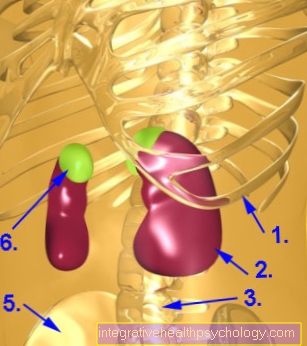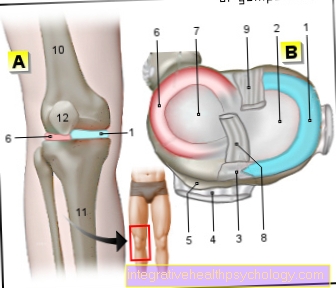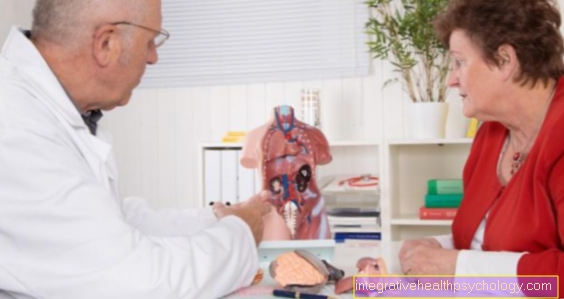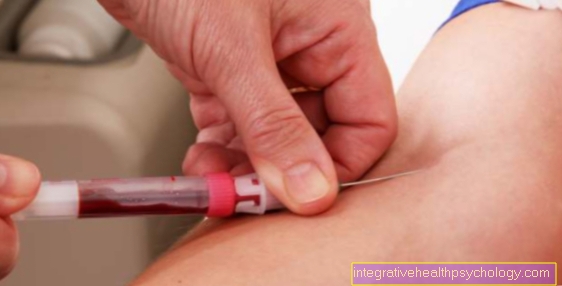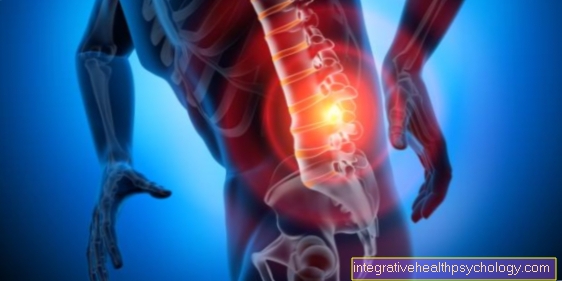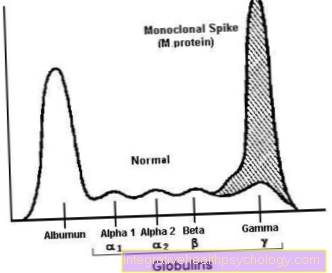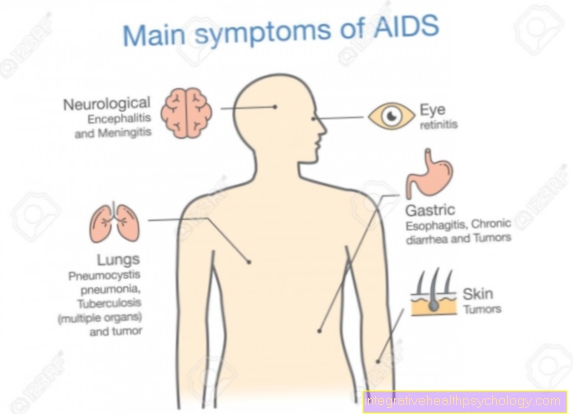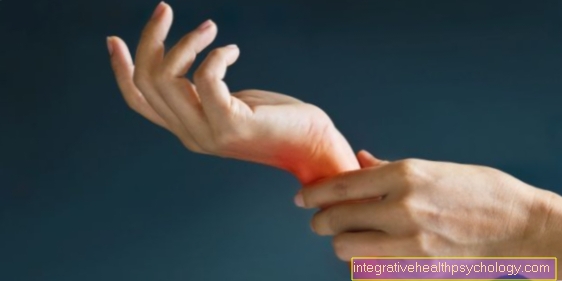Pain in hallux rigidus
introduction

Hallux rigidus is a common orthopedic disease that occurs on a Joint wear (Osteoarthritis) of the metatarsophalangeal joint of the big toe. After hallux valgus, one Misalignment of the big toe With Displacement of the metatarsophalangeal joint of the big toe towards the inner edge of the foot, it represents the second most common dysfunction of the big toe. Often, both diseases occur side by side. The cause is probably one Combination of overload, unsuitable footwear, pre-existing foot deformities and a traumatic injury to the foot. The resulting wear and tear of the articular cartilage between the first metatarsal bone and the base of the big toe results in severe pain at rest and especially when walking. This is ultimately accompanied by an increasing and ultimately also complete Stiffening of the joint (Hallux limitans).
Cause of pain
Real joints (Diarthrosis) stand out, in contrast to spurious joints (Synarthroses), by cartilage-coated bone ends between which the fluid-filled joint space is located. This is surrounded by a joint capsule. The cartilage ensures a smooth surface and thus fulfills the function that occurs in the movement of the joint to intercept the resulting friction and protect the underlying bone. At the same time, it is elastic and can therefore absorb shocks.
By excessive wear and tear due to age or illness This cartilage creates the clinical picture of osteoarthritis. The protective hyaline cartilage layer thins out and is replaced by inferior fiber cartilage and granulation tissue. A Regeneration of the hyaline cartilage is not possible. The breakdown of the cartilage substance leads to a painful increase in pressure in the underlying bone tissue, which causes microfractures. The rubbing of damaged cartilage and bone tissue against each other can even be heard at times and is called Crepitation designated. Small pieces of cartilage and bone can become detached from the rest of the tissue. If they get into the joint space, this can block the joint. In order to be able to absorb the increased pressure, arise at the joint edge New bone formation (Osteophytes), which ultimately cause the joint base to widen and become visible in the X-ray image.
All of these remodeling processes and the inadequate load-bearing capacity of the replacement tissue cause chronic inflammation to develop and instability in the joints. This can lead to severe pain, especially when moving.
Description of the complaints
Are early symptoms of all osteoarthritis Start-up pain in the affected jointwhich occur especially after previous periods of rest and subsequent movement. In addition, there are complaints after heavy and long-lasting stress, in the case of hallux rigidus after a long walk, typical. Advanced stages are characterized by exercise-independent movement pain and also pain in peace and at night out. Pain can also increase or decrease depending on the weather. Most importantly, moving the big toe up in Towards the back of the foot (Dorsiflexion) can cause discomfort. Increasingly, there are also inflammatory processes, which are characterized by swelling and tenderness of the joint and reddening and warming of the surrounding skin. Furthermore, the metatarsophalangeal joint of the big toe gradually stiffens until movement is hardly possible. Typically, most of these complaints affect one foot.
Since stepping on the ball of the foot is particularly painful, the foot is no longer properly rolled when walking and instead stepped on with the outer edge of the foot. This static incorrect load ultimately leads to pain and neighboring joints can be affected.
Treatment of pain
Depending on which Disease stage who has reached hallux rigidus, various treatment options are available. The ultimate goal is always Freedom from pain and one if possible good functionality of the foot. Drug pain therapy is always a cornerstone of treatment. In particular, pain medication, which not only pain reliever (analgesic), but also anti-inflammatory (anti-inflammatory) play an important role. These include ibuprofen and diclofenac, among others. The latter is suitable both as a tablet and in the form of an ointment for treating pain. If this pain medication is not sufficient, infiltration therapy is possible, in which a local anesthetic along with a cortisone preparation injected into the affected area. The former provides effective pain relief, while cortisol has an anti-inflammatory effect. Efficient pain treatment is also important because it is only through it that physiotherapeutic exercises for treating hallux rigidus are possible.
Another way to treat hallux rigidus and relieve pain is that Immobilizing the joint. This can be done either through a cast or a splint.However, this treatment is only used until the inflammation has subsided and other orthopedic aids can be used.
These include on the one hand Hallux rigidus insoles. These are reinforced under the big toe and in this way relieve the basic joint of the big toe. Based on a similar principle special orthopedic shoes, which are stiffened and partially thickened under the forefoot. As a result, the foot no longer rolls over the metatarsophalangeal joints when walking, but directly over the shoe. This leads to a significant relief of the arthritic joint and thus ultimately to a reduction in pain and a normalization of the gait pattern.
Special physical measures are also suitable for pain relief. This designation includes processes such as electrical and Hydrotherapy. In electrotherapy, direct or alternating current is used to generate the Improve blood flow to the inflamed area and relax the muscles. Hydrotherapy, on the other hand, relies on the use of water to alleviate symptoms, for example in the form of foot baths, wraps and alternating baths.
If the pain cannot be dealt with in any other way, remains as a last resort, the operation of the hallux valgus. Depending on the age and the exact symptoms of the patient, various interventions are available, ranging from simple stiffening to endoprostheses made of metal.


